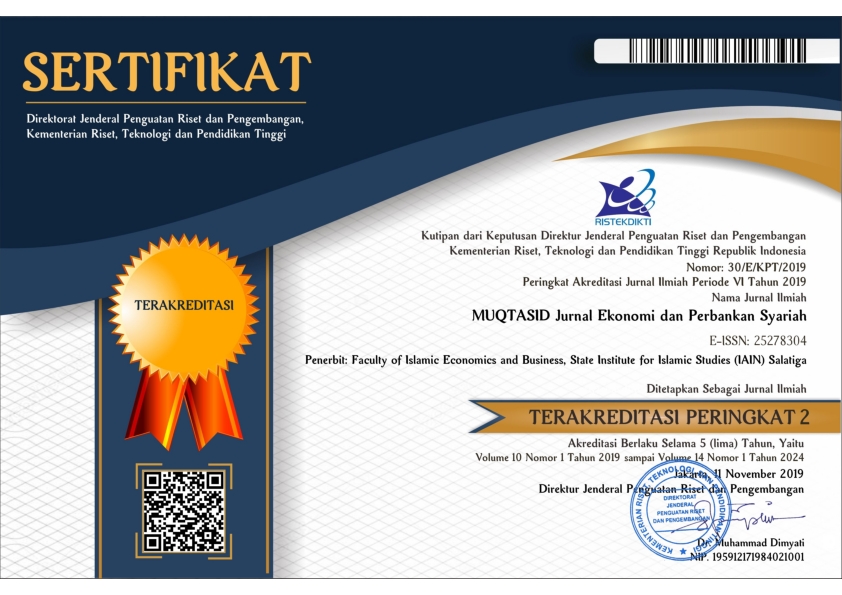Testing Weak Form of Stock Market Efficiency at The Indonesia Sharia Stock Index
Abstract
Abstract
Efficient Market is the market where all traded securities prices reflects all available information. Market Efficient Hypotesis in the Weak Form stated that past stock price movement incorporated with current securities’s prices, thus it can be used to predicting the current price or return. The objective of this research is to examine the weak form of Efficient Market Hypothesis (EMH) in Indonesia Sharia Stock Index (ISSI) over the period of January 3rd2017 -February 8th 2019. To Examine the EMH, some appropriate tests are developed, these are: Run Test, Autocorrelation Test, Autoregressive Integrated Moving Average (ARIMA), and Paired Sample t-test. The result findings showing that ISSI is not efficient in the weak form during the period of the study. Moreover, in accordance with time series modelling result, the fitted model is ARIMA (1,1,1) with accuracy level of 78%. This result proved that ARIMA model successfully and accurately in forecasting ISSI indices. It can be implied that the historical stock index data in the past still described the stock index information in the future. Thus, technical analysis is still feasible to do as the guide for investors in conducting transactions in the capital market.
Abstrak
Pasar yang efisien adalah pasar dimana semua harga sekuritas yang diperdagangkan telah mencerminkan semua informasi yang tersedia. Teori pasar efisien bentuk lemah menyatakan bahwa perubahan harga masa lalu tidak berhubungan dengan harga sekuritas sekarang, sehingga tidak dapat digunakan untuk memprediksi harga atau return dari sekuritas. Penelitian ini bertujuan untuk melakukan pengujian hipotesis pasar efisien bentuk lemah pada Indeks Saham Syariah Indonesia (ISSI). Data diambil pada periode 3 Januari 2017 – 8 Februari 2019. Pada tahap awal penelitian, Run test dan Autocorrelation test dilakukan untuk melihat apakah pasar efisien bentuk lemah berlaku pada ISSI. Selanjutnya dilakukan pembentukan pemodelan time series ARIMA untuk melihat teknik prediksi yang sesuai untuk memprediksi Indeks Saham ISSI. Hasil Run test dan Autocorrelation test menunjukkan bahwa hipotesis pasar efisien bentuk lemah tidak terbukti. Pada pembentukan model ARIMA, terlihat bahwa model yang sesuai adalah ARIMA (1,1,1) menghasilkan tingkat akurasi sebesar 78%. Hal ini membuktikan bahwa model ARIMA berhasil dan akurat digunakan untuk memprediksi Indeks Harga Saham ISSI. Oleh karena itu, analisis teknikal masih dapat digunakan oleh investor untuk menjadi pedoman dalam melakukan transaksi perdagangan di pasar modal.
Keywords
Full Text:
PDFReferences
Ackert, L.F., & Deaves, R. (2010). Behavioral Finance: Psychology, Decision-Making and Markets. Mason: South-Western Cengage Learning.
Amsi, M. (2019, February 14). Ikhtisar Statistik Saham Syariah Indonesia. Retrieved from http://www.syariahsaham.com/2019/02/ikhtisar-statistik-indeks-saham-syariah.html.
Andrianto, Y., & Mirza, A. R. (2016). A Testing of Efficient Markets Hypothesis In Indonesia Stock Market. Procedia - Social and Behavioral Sciences, 219, 99–103. https://doi.org/10.1016/j.sbspro.2016.04.048.
Ashik, M., & Kannan, S. (2017). Forecasting National Forecast Using ARIMA Model. Global and Stochastic Analysis, 4(1), 77–81.
Ang, W. R., & Weber, O. (2018). The Market Efficiency of Socially Responsible Investment in Korea. Journal of Global Responsibility, 9(1), 96-110, https://doi.org/10.1108/JGR-11-2016-0030.
Ayo, C. K. (2014). Stock Price Prediction Using the ARIMA Model. UKSim-AMSS 16th International Conference on Computer Modelling and Simulation. https://doi.org/10.1109/UKSim.2014.67.
Cahyadin, M., & Milandari, D. O. (2009). Analisis Efficient Market Hypothesis (EMH) di Bursa Saham Syariah, 2005:1-2008:11. La_Riba: Jurnal Ekonomi Islam, 3(2), 223–236. https://doi.org/10.20885/lariba.vol3.iss2.art6.
Forbes, W. (2009). Behavioral Finance. New York: John Wiley & Sons.
Guidi, F., & Gupta, R. (2011). Are ASEAN Stock Market Efficient? Evidence From Univariate and Multivariate Variance Ratio Tests. Discussion Papers in Finance, 201113, 488–502. Griffith University, Department of Accounting, Finance and Economics.
Gunarso, A., Siregar, H., & Irawan, T. (2017). The Stock Market of Infrastructure Sector: A Weak-Form EMH Test. International Journal of Science and Research, 6(2), 2015–2018. https://doi.org/10.21275/ART20171092.
Hase, G. J., & Haryono, N. A. (2018). Pengujian Efisiensi Pasar Pada Pasar Modal Indonesia Periode Juni 2009 – Juni 2015 (Studi Pada Indeks Harga Saham Gabungan). Jurnal Ilmu Manajemen Jurusan Manajemen Fakultas Ekonomi Universitas Negeri Surabaya, 6(4), 550–558.
Kustodian Sentral Efek Indonesia. (2018, Desember 27). Berita Pers: Inovasi untuk Kenyamanan Transaksi di Pasar Modal. Retrieved from KSEI: http://www.ksei.co.id/publication/press-releases.
Lilipaly, G. S., Hatidja, D., & Kekenusa, J. S. (2014). Prediksi Harga Saham PT BRI Tbk Menggunakan Metode ARIMA ( autoregressive integrated moving average ). Jurnal Ilmiah Sains, 14(2), 60-67.
Lusikooy, J., Nainggolan, N., & Titaley, J. (2017). Prediksi Harga Tutup Saham PT. Garuda Indonesia, Tbk Menggunakan Metode ARIMA. Jurnal MIPA Unsrat Online, 6(1), 74–77.
Mondal, P., Shit, L., & Goswami, S. (2014). Study of Effectiveness of Time Series Modelling (Arima) In Forecasting Stock. International Journal of Computer Science Engineering and Application (IJCSEA), 4(2), 13–29. DOI: 10.5121/ijcsea.2014.4202.
Nikita, M. P., & Soekarno, S. (2012). Testing on Weak Form Market Efficiency: The Evidence From Indonesia Stock Market Year 2008-2011.2nd International Conference on Business, Economics, Management and Behavioural Finance (BEMBS), 56–60.
Ren, L., & Ren, P. (2017). Testing The Market Efficiency By Mean Absolute Deviation. Benchmarking: An International Journal, 24(7), 2049–2062. https://doi.org/10.1108/BIJ-06-2016-0096.
Sabbaghi, O., & Sabbaghi N. (2018). Market Efficiency and The Global Financial Crisis: Evidence From Developed Market. Studies in Economics and Finance, 35(3), 362-385, https://doi.org/10.1108/SEF-01-2014-0022.
Saleh, T. (2019, January 21). Investor Saham Syariah Sudah Capai 44.000. Retrieved from https://www.cnbcindonesia.com/market/20190121162205-17-51636/investor-saham-syariah-sudah-capai-44000.
Shaik, M. (2017). Market Efficiency Of Asean Stock Market. Asian Economics and Financial Review, 7(2), 109–122. https://doi.org/10.18488/journal.aefr/2017.7.2/102.2.109.122.
Devi, B. U., Sundar, D., & Alli, P. (2013). An Effective Time Series Analysis for Stock Trend Prediction Using ARIMA Model for Nifty Midcap-50. International Journal of Data Mining & Knowledge Management Process (IJDKP), 3(1), 65-78, DOI: 10.5121/ijdkp.2013.3106.
Utami, A. T. (2018). Efisiensi Pasar Bentuk Lemah Pada Pasar Modal Indonesia, Malaysia dan Korea Selatan Periode Krisis Ekonomi Global 2008. Jurnal Inspirasi Bisnis dan Manajemen, 2(2), 101–116.
DOI: https://doi.org/10.18326/muqtasid.v10i1.17-29
Refbacks
- There are currently no refbacks.

MUQTASID by http://muqtasid.iainsalatiga.ac.id/ is licensed under a Creative Commons Attribution-ShareAlike 4.0 International License.
MUQTASID Jurnal Ekonomi dan Perbankan Syariah UIN SALATIGA p-ISSN: 2087-7013, e-ISSN: 2527-8304




